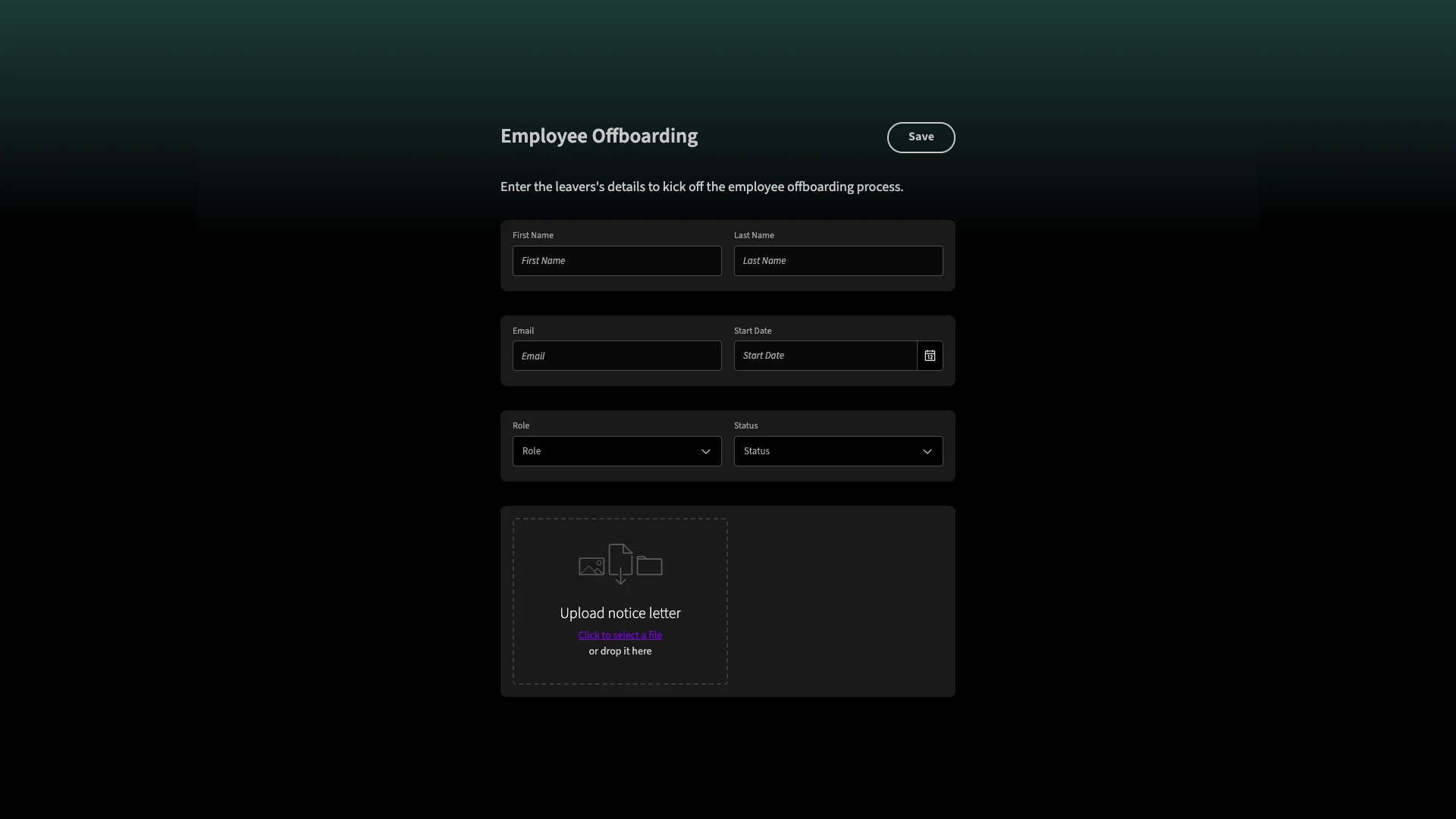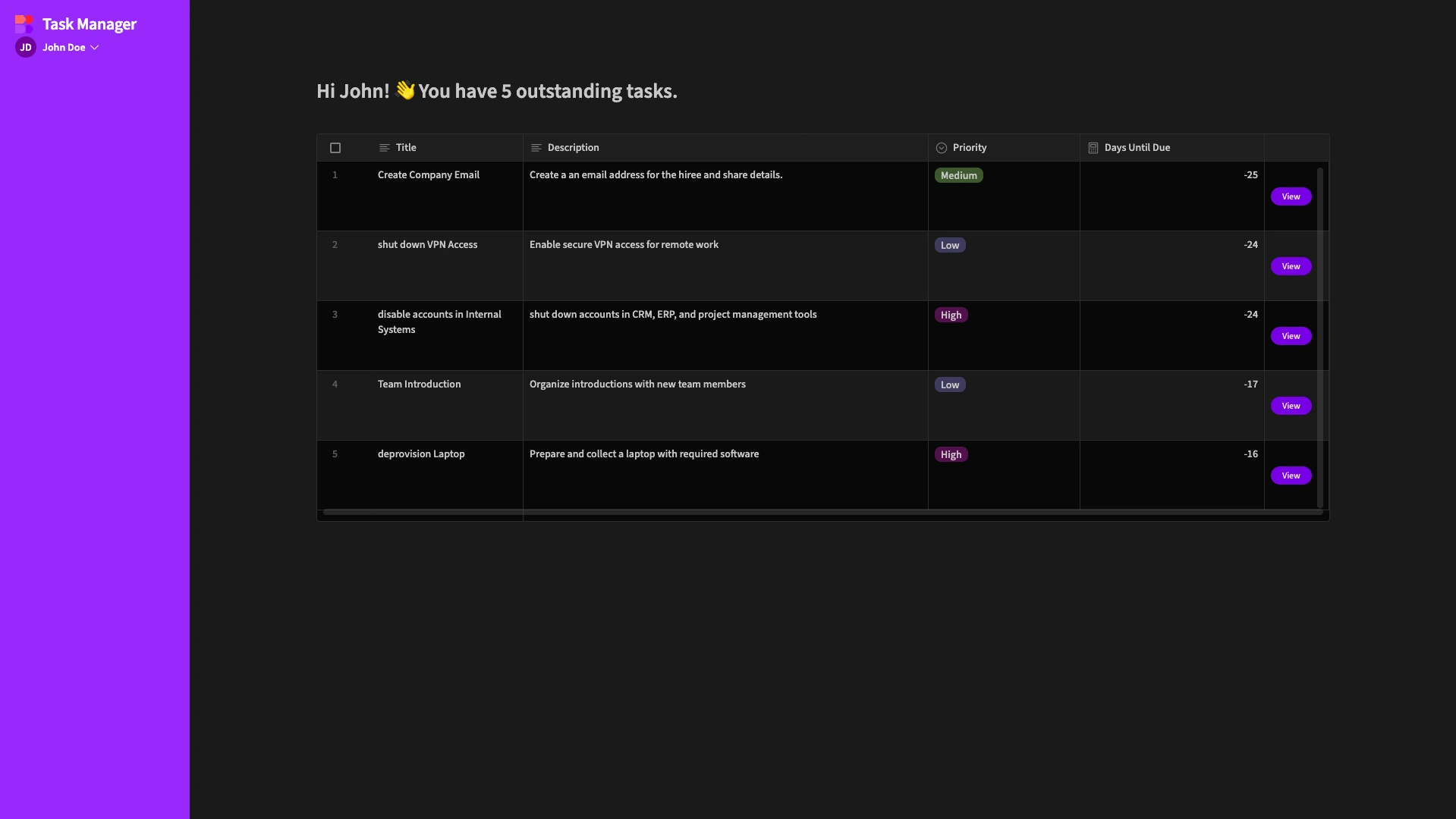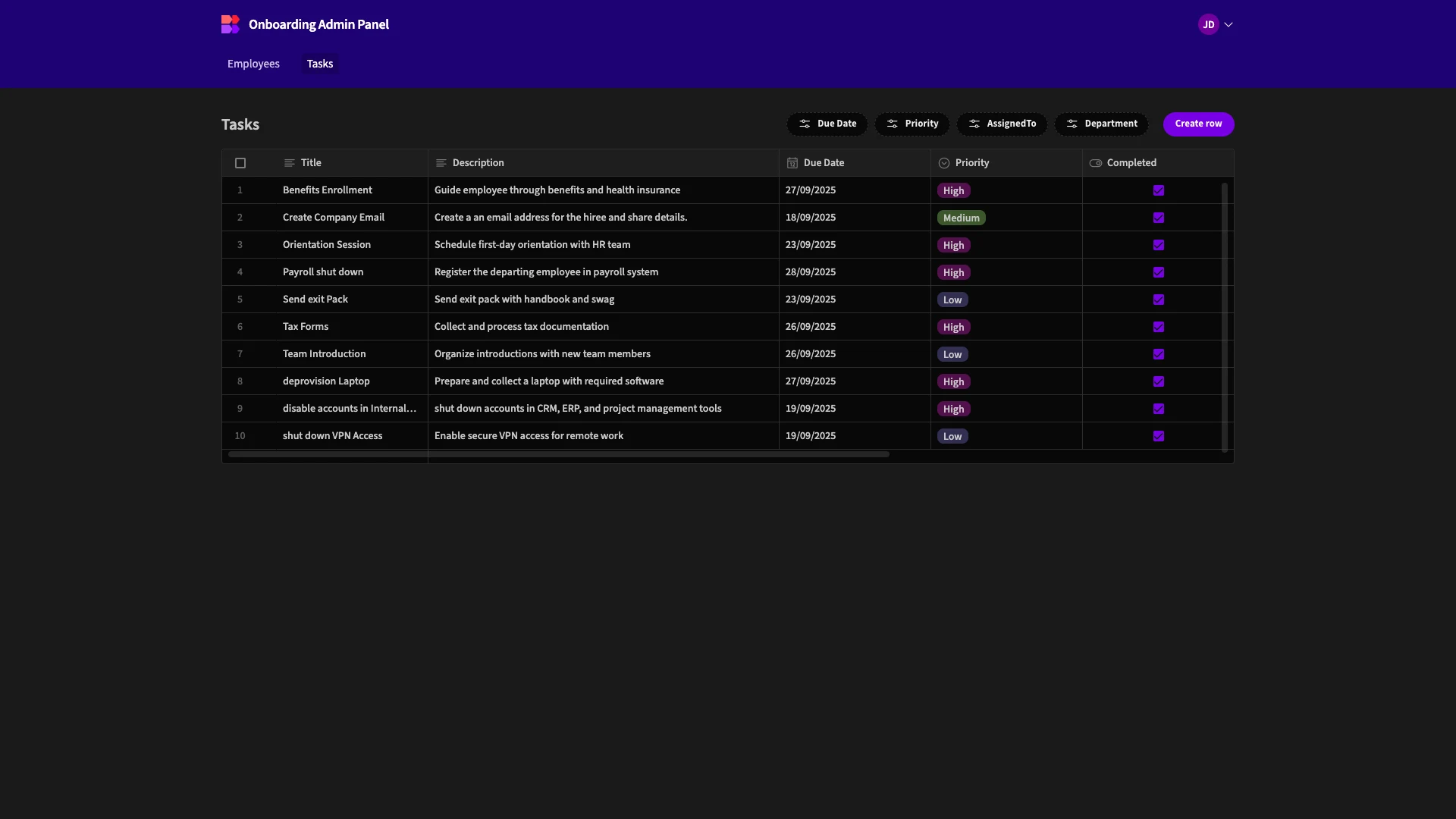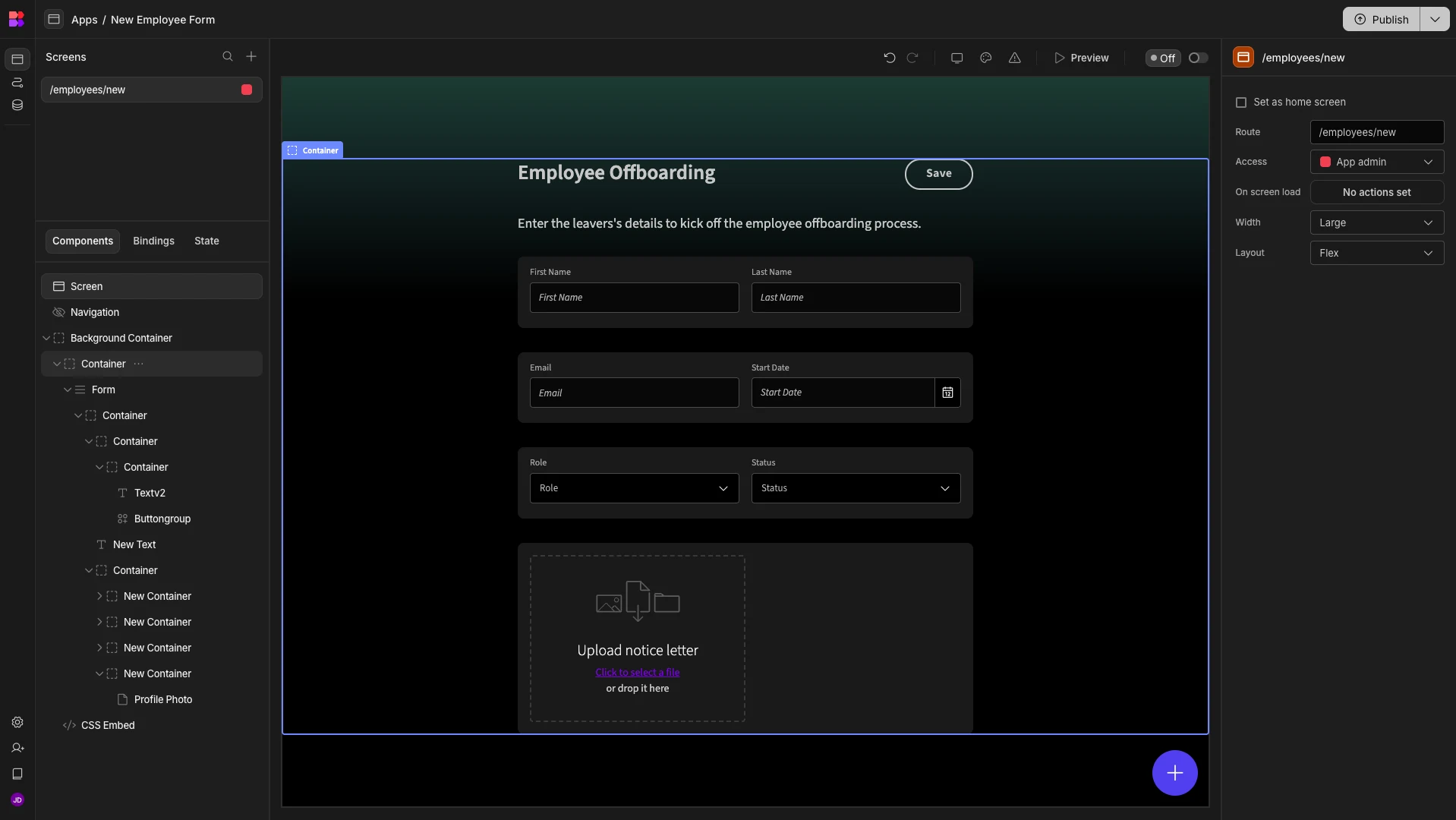
Employee Offboarding Processes | Ultimate Guide
It’s a fact of life that colleagues don’t stick around forever. However, when people leave our team, it can create huge admin workloads across IT, HR, finance, legal, and the leaver’s own department.
If we don’t get this right, we risk several issues relating to workloads, operational continuity, payroll, information security, internal communications, compliance, and more.
In the first part of this in-depth guide to employee onboarding processes, we’re outlining everything you need to know about developing robust systems to manage colleagues leaving your organization.
Along the way, we’ll examine the core challenges of offboarding, how to design effective processes, and the real-world systems and tooling you’ll need to implement this.
Specifically, we’ll be covering:
- What is employee offboarding?
- Why is offboarding important?
- 5 stages of the employee offboarding process
- Employee offboarding checklists and trackers
- Handling dependencies, sequencing, and scheduling
- Software tools and systems for employee offboarding
- How to automate the employee offboarding process
Let’s start with the basics.
What is employee offboarding?
Employee offboarding comprises all of the tasks that are required when a colleague leaves our organization. This begins from the moment that notice is given about their resignation or termination, and ends when they are fully removed from all day-to-day processes and systems.
We can’t simply allow colleagues to leave the office one day and then forget about them.

Instead, employee offboarding is a highly involved, cross-stakeholder process. For example, we need to schedule exit interviews, reallocate projects, calculate benefit entitlements, stop salaries, retrieve assets, remove access to systems, and much, much more.
However, what’s particularly challenging is that the specific tasks that are required here will almost always vary from one employee to the next.
For an extreme example, offboarding our CFO would be a much more involved, extensive process, compared to offboarding a summer intern in an admin role.
The important thing to recognize here is that, although offboarding might always follow the same overall structure, the constituent actions that we take need to be appropriate for the employee’s role, tenure, data access, workload, knowledge, and other factors.
In other words, offboarding processes are not always strictly deterministic. Instead, individual executions require us to identify the specific tasks that are required for each employee.
As such, offboarding can be a relatively challenging process, requiring a high level of oversight and coordination between interrelated tasks.
This has also historically made it a difficult process to automate. However, as we’ll see a little later, new technologies, including agentic AI, are changing the landscape here.
Why is offboarding important?
Before we begin to examine the tasks that make up an employee offboarding process in more detail, it’s important to understand exactly how this can have an impact, including in financial, operational, cultural, and other terms.
To make this as easy as possible to wrap our heads around, we can divide this into the costs associated with onboarding employees, as well as the value streams that an effective offboarding process can provide.
Costs
Firstly, we can deal with the direct costs of employee offboarding. The most important aspect of this is the time and effort our team needs to put in when a colleague leaves.
This primarily takes the form of administrative tasks, such as handling associated paperwork or deprovisioning, as well as more cognate tasks such as carrying out exit interviews, writing up reports, and sharing findings.
On top of this, there’s the workload associated with coordinating these tasks.
What makes this particularly challenging in the case of employee offboarding is the fact that we’ll need to draw on such a large and diverse range of colleagues.
Additionally, this means that offboarding can also introduce a range of unforeseen or indirect costs when not managed effectively.
For example, there are operational issues, such as failure to reassign the leaver’s tasks and projects or to document their knowledge and experience. At the same time, there are more specific risk factors, including those associated with failure to remove access to company systems.
As such, one of the primary goals of an effective employee offboarding process is to minimize these kinds of costs by ensuring a smooth, well-managed transition that minimizes risk and preserves continuity.
Value streams
In addition to costs, it’s also important to understand the value streams that can emanate from employee offboarding. This is an issue that can be easily overlooked, as it’s a little bit counterintuitive to think of colleagues leaving as an opportunity.
The reality, however, is that when done correctly, offboarding can provide organizational value across a few key areas.
The most obvious element of this is understanding why employees leave. Of course, we don’t expect our colleagues to stay forever, but understanding the reasons that specific employees leave can help us to maximize our retention rates.
Besides this, effective employee offboarding processes can drive improvements in a range of ways, including:
- Continuity and knowledge retention - offboarding presents an opportunity to document the leaver’s tacit knowledge and experience.
- Security and data hygiene - timely deprovisioning helps to ensure that data exposure is removed and we have the appropriate licenses, seats, and equipment for our real operational needs.
- Process improvement opportunities - colleagues who are leaving can provide unique insights into our operations, often by speaking more candidly than they would while in their role.
- Brand and culture - helping to strengthen our reputation within our industry.
- Alumni relationships and boomerangs - fostering good relationships with former colleagues can be a driver of partnerships, referrals, or rehires.
- Client and vendor relationships - helping us to protect revenue and relationships during personnel changes.
- Maintaining compliance - providing paper trails that can be relied on by finance, legal, and IT teams.
As such, when we design offboarding processes, it’s vital that we design for value, not just risk.
This means building in knowledge capture and feedback loops, alongside security, compliance, and continuity controls, in order to ensure that our offboarding process helps to drive value across the organization.
5 stages of the employee offboarding process
Earlier, we noted that offboarding processes can be somewhat variable, in the sense that the specific tasks that are required will differ for individual employees.
However, the overall structure of this is generally somewhat more fixed. That is, we can think of offboarding as comprising several distinct phases, which will apply in almost all cases.
Let’s take a look at the five core stages of the offboarding process in turn.
1. Initiation & planning (pre-exit)
Offboarding is always triggered by a particular event. This is usually notice of the employee’s resignation, retirement, or termination, but it could also be the end of a fixed contract, or an internal transfer to another role.
The initiation and planning stage of the offboarding process is largely focused on gathering information.
Specifically, we need to establish the exact details of the employee’s exit, including any associated risks, stakeholders, guardrails, and required changes.
Ultimately, the goal of this is to determine the more granular tasks that are required to effectively offboard our leaver.
So, specific actions that are required during the pre-exit stage include processing the initiation trigger, confirming exit dates, classifying the exit type, identifying associated projects and resources, developing a personalized task plan, and assigning ownership.
By the end of this stage, we should have a clear outline of the deliverables for the individual onboarding process, as well as which colleagues are responsible for each.
2. Access & asset controls (Day 0 to final day)
The access and asset controls stage of the offboarding process is largely concerned with requisitioning equipment and removing access to facilities and resources.
As well as revoking the leaver’s access, this ensures that all resources are properly accounted for within their respective lifecycle management processes.
Naturally, this pulls in colleagues from a few distinct teams and functions. For instance, IT typically takes the lead on revoking access to internal systems and retrieving end-user devices, while HR or facilities teams might be responsible for removing building access.
This is one area where some of the key challenges of employee offboarding become most apparent. Specifically, we can’t take a blanket approach to de-provisioning because we need to account for the assets and resources each employee has access to.
As such, this could potentially rely on close integration with a range of systems, including MDM tools, asset databases, CMDBs, shared mailboxes, account admin platforms, and more.
This also requires careful planning and management, including to prevent oversights or other human error within our de-provisioning efforts. Priorities here include providing appropriate visibility of task data, as well as relying on automation as far as possible.
By the end of the access and asset controls stage, the employee should no longer have access to company systems and resources, and any company-owned equipment should be returned and processed.
3. Knowledge transfer & continuity
The next stage of the offboarding process concerns how we deal with the leaver’s responsibilities, experience, and other aspects of their day-to-day role.
Specifically, the goal is to minimize disruption to our operations when an employee leaves the organization.
There are a few overlapping components to this, which may be of greater or lesser importance depending on the specific roles and responsibilities of the employee in question.
Firstly, there’s knowledge. More specifically, employees develop all sorts of tacit knowledge in their time in a role. This refers to undocumented, experience-based knowledge that is helpful for performing their role.
Second, there’s operational continuity. This concerns the more practical elements of managing workloads and other responsibilities as we transition the employee out of the organization.
As such, key deliverables for this stage of the offboarding process include SOPs, system runbooks, project statuses, stakeholder maps, client notes, and other types of knowledge creation and documentation.
Depending on the nature of the employee’s specific role, this can be achieved using a few distinct methods, including colleague shadowing, recorded demos, phased handovers, mentoring sessions, and more - all of which must be scheduled as part of the offboarding process.
Continuity may also concern more practical, administrative tasks. Often, this takes the form of a transfer of ownership and admin rights for internal resources, such as code bases or roles within workflows.
Whereas the previous stage dealt with removing permissions, ensuring continuity means transferring relevant access, along with any associated responsibilities, to a remaining colleague.
4. Formalities & exit operations
This is the stage where the majority of paperwork and administrative tasks required for official offboarding are performed. This includes the bulk of HR-led tasks, as well as a range of actions from finance and legal colleagues.
Essentially, this comprises all of the tasks that are required to formally remove a colleague from our organization.
Again, depending on the structure of our company, the role of the specific employee, and other factors, this can comprise a variety of tasks.
To get a clear picture of the practicalities, it’s helpful to consider this from the perspective of different functions and teams individually. So, core responsibilities can include:
- HR - confirming exit/last day and entitlements, updating HRIS, ending benefits, filing records, preparing references/settlements if needed.
- Finance - running final payroll (salary, unused holiday, deductions, BIK), issuing payslip, closing cards/expenses, settling advances, processing clawbacks, retaining records.
- Legal - preparing/confirming settlement terms, verifying process documentation, reminding of restrictions/confidentiality, approving exit communications/reference wording, setting retention.
- The leaver’s department - completing handover, returning assets, updating lists/resources, notifying customers/vendors, confirming completion to HR.
In addition to processing the offboarding, another priority at this stage is ensuring that this is handled in compliance with any relevant regulations. As such, a clear paper trail is vital.
So, by the end of this stage, as well as ending the employee’s formal relationship with our organization, we should also have a clear record in place of when and how this was processed.
5. Post-exit & alumni
The final stage of the employee offboarding process comprises any actions that are required after an employee’s relationship with the organization has ended.
As you might expect, this can be somewhat more varied than the previous stages. For example, in many cases, this might not include much beyond providing references or confirmation of their previous employment to new employers.
However, it’s often a more involved undertaking than this.
One important element of this is security and compliance auditing. That is, we must utilize the outcomes of the previous steps for individual employees to ensure that we comply with relevant security policies and other regulations with respect to our former colleagues more generally.
Besides this, we may find it necessary to put in place follow-up workflows as part of employee offboarding processes, particularly with regard to any aspects of this that the leaver themself is responsible for.
For instance, scheduling reminders if devices haven’t been returned by the required date.
Additionally, many larger organizations make a concerted effort to maintain good relationships with their former employees through alumni programs. Generally, this is either done with the goal of facilitating rehires, or fostering good relationships within their industry.
This can include strategies such as hosting industry events, scheduling check-ins, or distributing information resources that are relevant to the next step in the leaver’s career.
Employee offboarding checklists and trackers
One thing that should be clear from the previous section is that employee offboarding is a complex, multi-stakeholder process. This can be immensely challenging, as we’re required to coordinate and organize a diverse set of tasks across a range of teams.
So, having examined the kinds of tasks we might encounter at various stages of offboarding, as well as how we can identify these, we can move onto to thinking about the more practical side of how we can manage this process as a whole.
In other words, how can we conduct offboarding in a robust, fair, auditable, and controlled manner?
At the most basic level, this revolves around what’s known as an offboarding checklist.
Essentially, this is a representation of the tasks that must be completed in order to process offboarding, including who is responsible for each, and their present state at a given point in time.
For example, the following checklist is broken down by the various teams responsible for different tasks within the offboarding process.
Team | Offboarding Tasks |
|---|---|
| HR team |
|
| Finance team |
|
| Legal team |
|
| IT team |
|
| Line manager |
|
| The leaver |
|
In some organizations, this could take the form of an actual pen-and-paper checklist. Or, it might be handled with spreadsheets, a HRIS system, project management tools, or some other existing platform.
At the same time, an increasing number of teams are turning to more modern solutions to handle employee offboarding. Specifically, planning and tracking constituent tasks is fast becoming one of the most prominent use cases for agentic AI.
In these cases, an agent can map the offboarding workflow—identifying required steps and dependencies—then auto-assign tasks and send alerts to the right owners via existing channels or a dedicated offboarding system.
We’ll return to this a little later when we come to think about specific offboarding tools and automation solutions.
Handling dependencies, sequencing, and scheduling
Before we start looking at specific solutions, however, it’s important to turn our attention to how we can determine the appropriate order to carry out offboarding tasks.
The challenge here is that individual actions are often constrained by a range of different factors, including resource availability, scheduling, and dependencies on other tasks.
From a planning perspective, this can naturally create important difficulties.
Our priorities here are, first, determining the appropriate order to execute tasks in, and, second, overseeing the execution of this.
What makes this particularly tricky is the fact that certains subsets of tasks will be dependent on one another, while others can be carried our more or less independently.
There are a few key strategies we can rely on here to determine the appropriate sequence of offboarding tasks.
These include:
- Identifying hard dependencies - This is when one task must be completed before another can proceed. For example, the terminations has to be registered in the HRIS before payroll can be stopped.
- Dealing with preclusions - These are tasks that, once completed, will prevent other tasks from occurring. For example, we can’t transfer account ownership if the account has already been deleted.
- Identify parellizable work - Tasks that can occur simultaneously. For example, HR can process paperwork while IT is handling de-provisioning.
- Use a tracker or workflow tool - ensuring colleagues have visibility into the appropriate tasks for their needs. For instance, HR colleagues will need full oversight of the offboarding process, while departmental colleagues might only need to access their own tasks and certain dependencies.
- Automation where possible - at a minimum, we can notify colleagues when dependencies have been completed and their tasks can proceed. Alternatively, we can automate offboarding tasks in a more wholesale fashion, for instance, triggering IT account de-provisioning or confirmation email flows when a termination notice has been submitted in the HRIS.
As you can see, having the right tools in place is critical to this.
Our priorities here include centralizing offboarding data, coordinating tasks across different teams, and building automation logic that can reflect the complex, varied nature of offboarding processes.
Low-code tools like Budibase are particularly useful here, enabling us to create custom portals, admin panels, and approval apps on top of any data, as well as leveraging custom RBAC, AI-powered automations, free SSO, and much more.
Software tools and systems design for employee offboarding
With a firm idea of the challenges that we’ll need to overcome within our employee offboarding processes, we can start to examine the concrete solutions we can build to help us achieve this.
While there’s plenty of scope for variation here, most solutions will rely on a combination of the following components.
Data models for offboarding processes
The first thing we’ll need is a suitable data model for our offboarding process. This is the structure of entities that underlie our workflows.
At the most basic level, offboarding requires two key entities - employees and tasks. That is, we have an employee who’s leaving the organization, and a set of tasks that must be completed to achieve this.
Our employees will generally already exist within a HRIS, but we may need to create a tasks schema when we develop our offboarding process.
Of course, real-world offboarding workflow systems will typically store additional data objects, representing departments, files and resources, roles, systems, assets, requests, or other relevant entities.
User management is also highly relevant here. That is, we’ll need to be able to associate users across our various systems with other data entities. For instance, to assign tasks to colleagues.
Similarly, we’ll need appropriate access control to reflect different users’ required level of data exposure. For example, HR colleagues might need oversight over all tasks, while other teams might only need to access items that they themselves have been assigned to.
Form UIs
Form UIs are an essential tool for enabling users to interact with data within all sorts of workflows. As part of various offboarding tasks, we’ll need to collect data in a predefined, structured format.

As such, having the ability to quickly output professional forms is critical.
On the one hand, there will be certain core types of forms that are central to all executions of our offboarding process. This includes basic tasks like registering the employee’s notice or creating tasks.
What makes this more challenging, however, is that we’ll often need to collect distinct information to offboard individual employees. This could be based on their role, seniority, employment terms, or other factors.
As such, offboarding processes are often a relatively advanced form-building use case. To reflect this, we can rely on a number of strategies for creating dynamic forms. These include:
- Utilizing conditional logic within forms - Using a single form for all executions of a given task, but dynamically displaying fields based on business logic.
- Conditionally sending static forms - Creating several static versions of a task-specific form, but applying business logic to determine which version to use for an individual execution of our offboarding process.
- Dynamic form generation - Leveraging agentic AI to determine the required data fields, generate a form, and send it to the appropriate user, as part of an offboarding automation flow.
Each of these presents its own benefits and challenges. For instance, the first two can be more reliable and easier to manage, but require us to have a discrete, pre-defined set of possible data schemas we might want to utilize.
Chatbots
At the same time, a growing number of teams are moving away from strictly structured data collection UIs within internal workflows, including employee offboarding.
With the rise of agentic AI, more and more data management tasks are carried out via natural language interactions.
These might rely on dedicated tools, or they might instead leverage existing communications tools, such as Teams or Slack.
In either case, the goal is to establish workflows where users can submit overarching goals, and AI-based systems assess the context to determine how these can be achieved, before taking action autonomously.
For example, we could ask a chatbot to initiate offboarding an employee. It would then follow up to gather the required information before triggering the appropriate automated actions, including creating tasks to assign to human users, where required.
Take a look at our in-depth guide to digital workers to learn more.
Task management
As we said earlier, one of the key challenges of employee offboarding is the need to manage a diverse range of tasks across various internal teams.

This is vital for ensuring that all required actions are carried out and recorded, as well as being executed in the appropriate order.
Two crucial components to this are the ability to assign tasks to specific teams or colleagues and reflecting dependencies so that individual colleagues are aware when their assigned tasks are due.
Therefore, role-based access control is a core requirement for effective task management solutions. That is, the ability to provide colleagues with the exact right permissions to carry out their assigned tasks.
For example, we might enable HR teams to carry out full CRUD operations on our task data, while IT or finance teams only need to read and edit the existing tasks they have been assigned to.
Individual tasks will typically contain a due date and a status attribute to provide insight into their current state and when they will be completed.
HR and IT admin panels
To successfully manage employee offboarding processes, we’ll also need to provide certain colleagues, especially those in IT and HR teams, with experiences for carrying out basic admin tasks.

Often, this takes the form of an Admin Panel. Essentially, this is an end-user tool that enables colleagues to carry out core admin tasks, often in the form of CRUD operations on our Tasks data.
There are a couple of core uses for this. Firstly, admin panels enable our team to create our overall task list.
Second, they can overwrite and edit existing workflows, including those that have been created manually or via automated tools. For instance, updating statuses and due dates, or adding and removing tasks entirely.
Workflow automation
Lastly, employee offboarding processes typically make heavy use of workflow automation tools. As we’ll see in a moment, this can take a few different forms depending on the sophistication of our use case.
For now, though, the important thing to recognize is that automation tools enable us to create efficient, reliable workflows by replicating decisions and actions that would otherwise require manual human input.
For example, triggering actions based on defined events or sending notifications when certain tasks change status.
Perhaps more importantly, in the case of offboarding processes, workflow automation tools also provide key integration capabilities.
For example, enabling us to trigger actions within an ITSM platform based on changes to data in our HRIS, without having to set this up manually via API requests.
How to automate the employee offboarding process
To wrap up this first part of our two-part guide to employee offboarding processes, we’re going to discuss some of the unique challenges with implementing automation solutions for this use case.
Earlier, we discussed the fact that, although certain elements will always be similar, offboarding processes can vary greatly from one execution to the next.
As such, any automation solutions we opt for will need to reflect this. So, we need to understand the different approaches to automation which are available to us, as well as their respective roles in overall solution development.
Deterministic automations
A deterministic automation is one where static logic is applied so that, for the same inputs, the same outputs will always be reached.
In the simplest forms, these can consist of a single trigger and action. So, if this happens, do that.
We can also create more complex deterministic automations, including branching, looping, and conditional logic. However, the important thing to recognize is that static logic still underpins this.
Deterministic automations can be hard-coded or built using visual automation platforms, such as Budibase.
This type of automation forms the basis of most internal workflows, by enabling us to carry out repetitive tasks in a reliable, efficient manner.
Deterministic automation rules are widely used within employee offboarding use cases. For example, to handle notifications, de-provision accounts, schedule meetings, or escalate overdue tasks.
To some extent, we can even reflect some of the variations within offboarding processes using deterministic tools.
That is, we can manually create logic to execute different flows for specific roles, only triggering certain constituent tasks that are relevant to their needs.
For example, if we created multiple static flows for individual job roles, and triggered these using deterministic logic.
This is a strong approach in large organizations that regularly hire colleagues in similar roles, but it might not be viable for lower-volume use cases.
Similarly, as offboarding is an inherently complex, multi-stakeholder process, there are fringe cases and common roadblocks that deterministic automations might not handle well.
For instance, if certain colleagues or resources are unavailable to carry out certain tasks, this can delay the entire process, unless we put in place fallback steps, which can be difficult to do for all possible edge cases.
Because of this, more and more teams are also implementing alternative approaches to automations within their offboarding workflows.
Leveraging agentic AI in employee offboarding
As we alluded to earlier, agentic AI refers to software systems that leverage LLMs in order to autonomous reason, assess context, and carry out actions in pursuit of a given goal.
In the first instance, this facilitates natural language interactions with automated systems. For example, allowing HR colleagues to provide a chatbot with the requirements to offboard a colleague, without necessarily utilizing a pre-defined data schema.
As such, agentic AI is highly suited to reflecting the granular needs of individual offboarding executions.
On top of this, as agents are able to asses their context and perform independent reasoning, they’re often a more suitable choice for complex, highly varied automation use cases, such as offboarding.
For example, if dependent tasks are held up by a colleague being out of office, agents can create and implement backup plans on the fly, preventing undue delays.
However, agentic AI also introduces important challenges and limitations.
Crucially, employee offboarding is a highly sensitive process, dealing with personal information and access to potentially mission-critical systems.
As such, we still need to prioritize reliability and predictability.
In light of this, a growing number of teams are choosing to utilize agentic AI alongside traditional deterministic automations.
For example, providing defined workflows that agents can call as functions, or utilizing agentic systems for specific actions and steps within otherwise deterministic rules.
To learn more about how this can work, take a look at our guide to the top open-source AI agent platforms .
Turn data into action with Budibase

Budibase is the open-source, low-code platform that empowers IT teams to turn data into action.
We offer extensive external data support, custom RBAC, autogenerated UIs, powerful AI-driven automations, free SSO, optional self-hosting, and much more.
Check out our features overview to learn more.